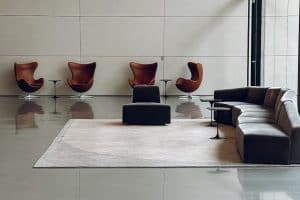
The debate between artificial turf and natural grass has gained significant traction in recent years. Homeowners are increasingly weighing their options, and many are leaning toward synthetic solutions.
This shift stems from a variety of factors that appeal to both practicality and aesthetics. Let’s explore the reasons behind this growing trend.
Low Maintenance Requirements
One major draw of artificial turf is the minimal upkeep it demands. Traditional lawns require regular mowing, watering, weeding, and fertilizing.
For busy homeowners juggling work, family, and social commitments, this maintenance can feel like a burden. On the flip side, synthetic grass eliminates the need for all of these tasks.
Just a periodic rinse with water to remove dust and debris is often enough to keep it looking fresh.
Fewer maintenance tasks translate to reduced costs over time. Homeowners save on their water bills and lawn care services, which can add up quickly.
This practical aspect makes artificial turf especially appealing for those looking to streamline their household chores.
Environmental Considerations
Water conservation is becoming increasingly important in many regions. With changing climate patterns leading to droughts and water shortages, synthetic grass offers a sustainable alternative.
Unlike natural lawns, artificial turf does not require regular watering, making it an eco-friendly choice for homeowners concerned about their environmental footprint.
Moreover, synthetic grass eliminates the need for chemical fertilizers and pesticides, which can be harmful to local ecosystems.
This environmental consideration is a significant reason why many people are turning to artificial solutions that align with their values and commitment to sustainability.
For those interested in eco-friendly landscaping, visit artificialturftoronto.ca to learn more about sustainable synthetic turf options.
Aesthetic Appeal
Artificial turf has come a long way since its inception. Modern synthetic grass is designed to look and feel like the real thing, often making it difficult to tell the difference at first glance.
Homeowners can enjoy the lush, green appearance of a perfectly manicured lawn without the associated labor.
Additionally, the color and texture of artificial turf can be customized to fit the unique style of a home. Whether someone prefers a bright, vibrant green or a more muted tone, options abound.
This personal touch enhances the overall aesthetic appeal of the property, making it more inviting for both residents and guests.
Durability and Longevity
When it comes to durability, artificial turf shines. Natural grass lawns can be susceptible to wear and tear from foot traffic, weather changes, and pests.
This can lead to unsightly patches and bald spots, requiring re-seeding or patching. In contrast, synthetic grass is designed to withstand heavy use and remain intact over time.
High-quality artificial turf is typically backed by warranties that cover 8 to 15 years or more. This longevity provides homeowners with peace of mind, knowing that their investment will last.
While the initial cost may be higher than sod, the long-term durability often makes it a wise financial decision.
Safety and Health Benefits

Another compelling reason homeowners are opting for artificial grass is safety. Many synthetic turf products are designed with non-toxic materials, making them suitable for children and pets.
Unlike natural grass, which can harbor insects and allergens, artificial turf provides a cleaner, safer play surface.
In addition, the absence of mud and dirt means fewer messes tracked into the house. This clean aspect is particularly appealing for pet owners, as synthetic grass is often easier to clean and maintain than traditional lawns.
Owners can simply pick up after their pets without worrying about muddy paw prints.
Versatility in Applications
Artificial turf isn’t just for residential yards—its uses extend far beyond traditional lawns. Homeowners are discovering its versatility in creating play areas, pet runs, and even rooftop gardens.
Its ability to withstand harsh conditions makes it suitable for diverse environments, whether it’s a sunny backyard or a shaded terrace.
Furthermore, synthetic grass can be installed in spaces where natural grass struggles to thrive, such as shaded areas or places with poor soil quality.
This adaptability allows homeowners to create beautiful green spaces in areas where traditional grass might not flourish.
Cost-Effectiveness Over Time
While the upfront cost of installing artificial turf can be a concern for some, many homeowners find that it pays off in the long run.
The savings from reduced water usage, maintenance costs, and the longevity of the material can significantly outweigh the initial investment.
Moreover, the potential increase in property value can’t be ignored. A well-maintained yard—artificial or natural—can enhance curb appeal, making a home more attractive to prospective buyers.
In many cases, the decision to go with synthetic grass can lead to a favorable return on investment when it comes time to sell.
Seasonal Advantage
In regions with extreme weather conditions, maintaining a natural lawn can be a challenge. Harsh winters can leave grass brown and lifeless, while scorching summers can lead to dry patches.
Artificial turf, on the other hand, remains consistent regardless of the season. Homeowners can enjoy a green lawn year-round without the stress of seasonal upkeep.
This advantage is particularly beneficial for those living in areas prone to drought or heavy rainfall.
Artificial grass helps maintain a visually appealing landscape regardless of fluctuations in weather, ensuring that homeowners have a vibrant yard all year long.
Technological Innovations
The field of artificial turf has seen significant advancements in technology. Innovations in materials and design have led to more realistic textures and colors, making synthetic grass even more appealing.
Many products now incorporate features such as drainage systems and antimicrobial properties, enhancing functionality.
These improvements have elevated the perception of artificial turf from a mere alternative to a preferable choice. Homeowners are excited about the technological advancements and how they contribute to a better gardening experience.
Social Influences and Trends
The trend toward artificial turf is also influenced by social media and lifestyle branding. With the rise of platforms showcasing beautiful homes and gardens, many homeowners are inspired to create their ideal outdoor spaces.
As more influencers and designers highlight the benefits of synthetic grass, the stigma surrounding it continues to diminish.
Moreover, the community aspect of sharing home improvement projects encourages others to follow suit. Seeing neighbors or friends opt for artificial turf can influence decisions, creating a ripple effect in neighborhoods.







